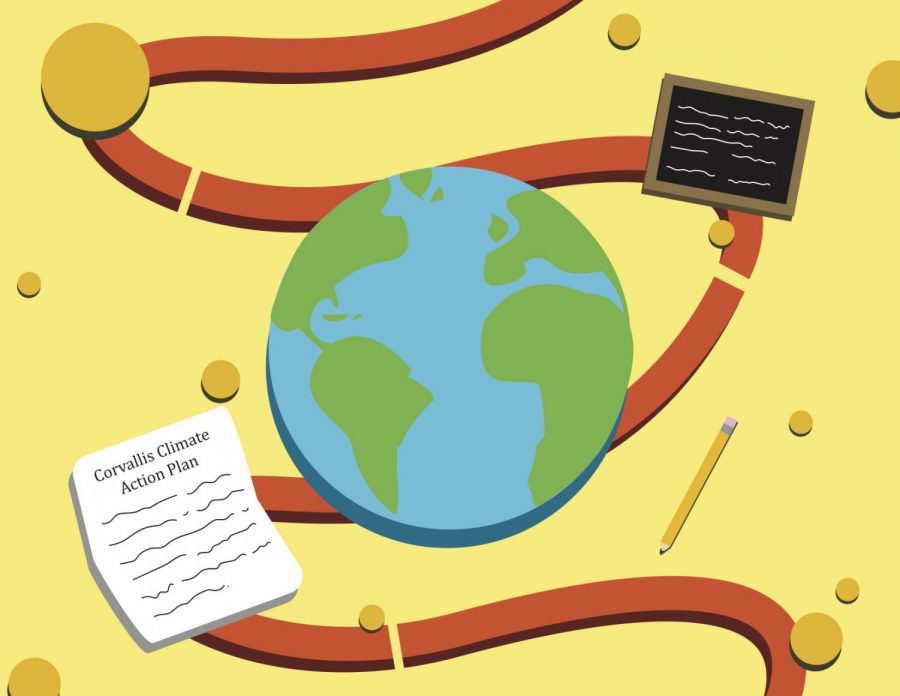Corvallis Climate Action Alliance aims to push policy, coordinate Earth Month
February 10, 2020
Spearheading a city-wide effort to spread climate awareness, the Corvallis Climate Action Alliance has declared the month of April to be ‘Earth Month,’ commemorating the 50th anniversary of the original Earth Day.
The CCAA was formed in June 2019 in order to organize local environmental groups like the Corvallis chapter of the Sunrise Movement, the Corvallis High School Green Club and the Pacific Green Party for the September 2019 Global Climate Strike. While many of these groups planned and hosted events, there wasn’t a sense of cohesion between the units.
“Strike week, people were talking about bringing a resolution to City Council that we were in a climate emergency…as they were getting started, it came to their attention that the League of Women Voters has already done that,” says Jean Womack, a member of the CCAA Outreach Committee. “It became very apparent that we need to be talking to each other.”
Womack originally thought of the Earth Month concept last year, under the belief that devoting just a day to the planet isn’t enough, and having events in such close proximity to each other burns activists out. Over 10 events took place during the week of the Global Climate Strike, and many members could only attend one or two.
Over 15 organizations in Corvallis are currently working with the CCAA. These organizations still operate independently, with representatives often attending weekly CCAA meetings. The presence of the alliance aims to boost the publicity and support for individual interest groups, rather than acting as a governing body.
“We figured what we could do is collaborative publicity, and cooperate around what [events] other people are already doing and ask, ‘what can we do to enhance and augment the publicity around them?’ and in that way, make it feel like a bigger deal. It’s not these isolated, little separate activities, it’s more of a big, coordinated push,” Womack said.
The alliance has outlined four primary goals. The first two are to get the City of Corvallis to implement its Climate Action Plan and to undertake an emergency-level response. The last two are to promote climate legislation at the state level and educate public audiences about the climate crisis.
Over 500 Corvallis residents were present at the Sept. Climate Strike. With around 15 events currently planned for April, CCAA members hope Earth Month will further galvanize the community’s interest towards climate action.
“[Earth Month is] what really got my attention in the beginning…I remember Earth Day, I was part of organizing it on my campus 50 years ago,” said Carl English-Young, a member of the CCAA Steering and Publicity Committee.
Primarily comprised of Corvallis community members, the organization is still looking for opportunities to connect with Oregon State University students. There are currently plans to get OSU students more involved with city climate policy but these plans haven’t been implemented as of yet. Jillian Gregg, an OSU climate change professor and OSU liaison for the CCAA, says that the best way for students to get involved is through the local Sunrise chapter.
“The Corvallis Hub of the Sunrise Movement and the Corvallis and Crescent Valley High School green clubs were instrumental partners that made the CCAA a success last summer. It is essential that the CCAA has young voices as part of this group, as they provide the motivation for action,” Gregg said.
Members said they feel that building a connection with OSU students is going to be essential in pushing climate policy for the city. There’s also a sense that serious progress is being made towards increasing student involvement. According to Womack, over 250 students participated in the Sept. 27 strike, while previous climate events had rarely eclipsed 60 student participants.
“It was a big relief. A big sense of making headway. Students want to do stuff, it’s just what do you do?” Womack said. “I’ve kept seeing this statistic over and over again. If you can get 3.5% of the population in the streets, you will get it.”










































































































